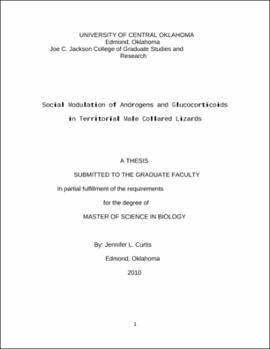| dc.contributor.advisor | Baird, Troy A. | |
| dc.contributor.author | Curtis, Jennifer L. | |
| dc.date.accessioned | 2020-05-26T20:34:39Z | |
| dc.date.available | 2020-05-26T20:34:39Z | |
| dc.date.issued | 2010 | |
| dc.identifier.other | (AlmaMMSId)9978555185202196 | |
| dc.identifier.uri | https://hdl.handle.net/11244/324638 | |
| dc.description.abstract | "The challenge hypothesis predicts that breeding strategy and degree of parental care may modulate within season hormone levels and androgen responsiveness to social challenges in males. Hirschenhauser and Oliveira (2006) expanded this theoretical framework to separately test the roles of sexual, paternal, and agonistic behaviors on androgen responsiveness. The social stress hypothesis predicts that males exposed to repeated challenges will increase corticosterone levels which may have an antagonistic effect on testosterone level. To test these hypotheses, I measured plasma testosterone and corticosterone in male collared lizards over the activity season (April-July) to examine potential variation in Baseline hormone levels. I also exposed resident territorial males to either 15 min conspecific intrusions or an empty noose-pole over four consecutive days to examine androgen and glucocorticoid responsiveness to Acute (Day 1) and Chronic (Days 2, 3, and 4) challenges. Inconsistent with the predictions of the challenge hypothesis, males did not maintain peak testosterone levels across the activity season. Testosterone levels peaked in April and June, and were significantly lower in May and July. This temporal pattern of testosterone concentrations is similar to the temporal pattern of courtship activity reported by a previous study on males in the same population. Males that were challenged by an intruder responded more aggressively than controls in June, but not in May, perhaps because during June males are courting females frequently. Males did not increase testosterone in response to challenges, and even exhibited a tendency for decreased testosterone between baseline and acute experimental phases. These results are consistent with Hirschenhauser and Oliveira's (2006) finding that agonistic behavior does not consistently prompt increased androgen levels among vertebrates. Decreased testosterone in collared lizards may be attributed to the threat of losing social dominance, or the reduction in courtship activities during challenges. Temporal correspondence of high testosterone levels in my study with periods of peak courtship frequency reported by Baird et al. (2001), suggests that courtship may prompt secretion of androgens. Corticosterone levels did not increase following single or repeated intrusions, which does not support the predictions of the social stress hypothesis, or allow for the possibility of an antagonistic interaction between corticosterone and testosterone in collared lizards. Two possibilities for the lack of a stress response to challenges are that intruder males were not perceived as a threat, or that I may not have measured the most biologically relevant form of corticosterone."--Abstract." | |
| dc.rights | All rights reserved by the author, who has granted UCO Chambers Library the non-exclusive right to share this material in its online repositories. Contact UCO Chambers Library's Digital Initiatives Working Group at diwg@uco.edu for the permission policy on the use, reproduction or distribution of this material. | |
| dc.subject.lcsh | Collared lizards | |
| dc.subject.lcsh | Courtship in animals | |
| dc.subject.lcsh | Glucocorticoids | |
| dc.subject.lcsh | Testosterone | |
| dc.title | Social modulation of androgens and glucocorticoids in territorial male collared lizards. | |
| dc.type | Academic theses | |
| dc.contributor.committeeMember | Barthell, John | |
| dc.contributor.committeeMember | Hews, Diana | |
| dc.contributor.committeeMember | Stone, Paul A. | |
| dc.thesis.degree | M.S., Biology | |
| dc.identifier.oclc | (OCoLC)ocn840828588 | |
| thesis.degree.grantor | Jackson College of Graduate Studies | |
